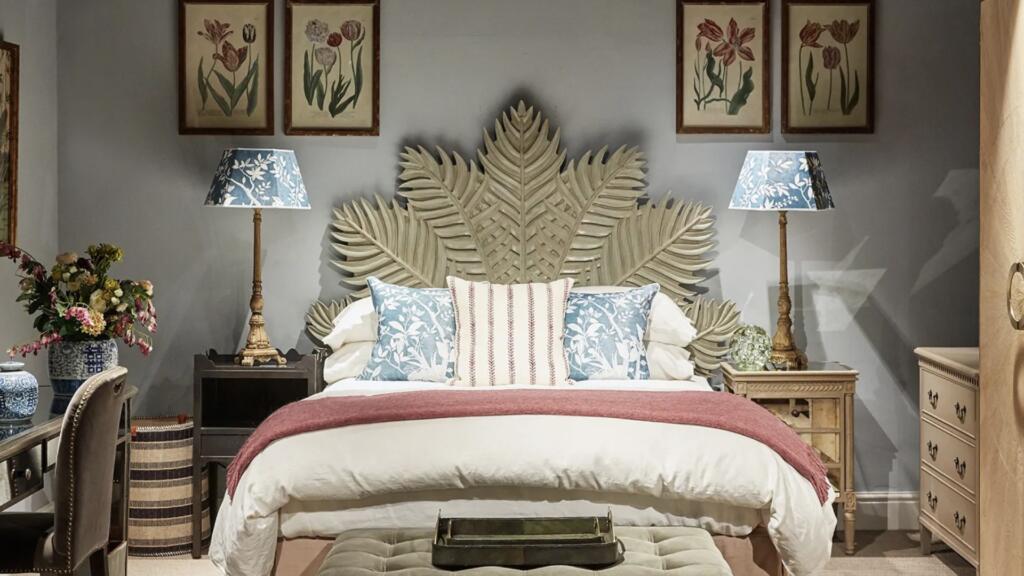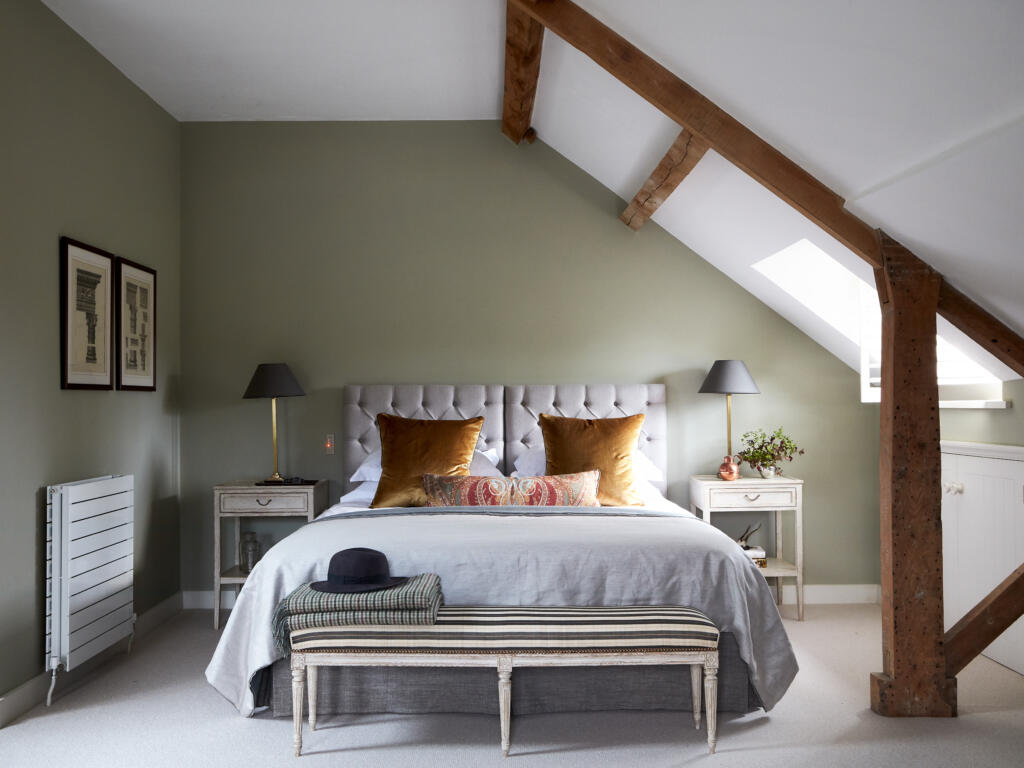
Chic ways to use grey in a bedroom that are anything but gloomy
Joy Archer
If you want your boudoir to feel more hotel chic than DIY, wall panels take some beating.
Forget paper or paint. When it comes to decorating the walls of your home, panelling is the latest stylish solution. Inspired by the interiors of both chic city-centre hotels and classic country boltholes, wall panelling – basically, raised panels of wood – can offer a fresh, textured feel to your interiors.
Having experienced a resurgence recently via social media, panelling has become an especially popular option for the bedroom. Emma Deterding, founder and creative director at Kelling Designs, explains: “Panelling brings a tactile and warming quality. In the bedroom in particular, it can allow you to upscale the space with a luxurious and timeless finish, adding a real sense of grandeur.”
Forget paper or paint. When it comes to decorating the walls of your home, panelling is the latest stylish solution. Inspired by the interiors of both chic city-centre hotels and classic country boltholes, wall panelling – basically, raised panels of wood – can offer a fresh, textured feel to your interiors.
Having experienced a resurgence recently via social media, panelling has become an especially popular option for the bedroom. Emma Deterding, founder and creative director at Kelling Designs, explains: “Panelling brings a tactile and warming quality. In the bedroom in particular, it can allow you to upscale the space with a luxurious and timeless finish, adding a real sense of grandeur.”
 Credit: Richard Burbridge
Credit: Richard BurbridgeSo if you’re looking for an easy, on-trend way to update your bedroom, wall panelling could be the answer. For inspiration on designs and materials that could suit your own bedroom, we spoke to interior design experts who use panelling regularly in their own work.
Wainscoting is a thinner type of panelling

There are a couple of different options for bedroom wall panelling, but thinner, traditional panelling (often referred to as moulding or wainscoting) can be a superior choice for those who would prefer a more subtle, modern but high-end look.
Sophie Clemson, design director and co-founder of The Living House, says: “Shaker-style panelling is very popular but it can look heavier due to the thicker lines, whereas traditional panelling is more elegant. If you want to create a timeless-looking bedroom, this style is for you.”
And although it can be a tricky DIY option, it is possible, says Clemson: ”Traditional wall panelling can be created using moulding MDF strips, which are easy to find in any hardware store.”
Shaker style panelling has an army of fans

If you’ve seen panelling on social media, it’s likely to have been created using Shaker wall panels. While it might be argued that Shaker panelling is less sophisticated than traditional panelling, it’s popular in bedrooms for a reason.
Nicole Sage, interior designer and owner of Sleek Chic, explains: “This type of panelling brings instant character, and a much more defined look than a traditional painted wall.
“Because of this, this style is most suited to cottages and more rustic interior styles.”
If you fancy installing your own wall panelling, this is likely the style you’d have most success with. “Shaker panels are by far the simplest type to install without professional help,” says Sage. “It’s an accessible and easy DIY project.”

For those in older homes, choosing square panels over rectangular ones in your bedroom make a lot of sense. “Square panelling is associated with older properties,” Clemson says. “As such, we recommend this if you have a period home where you may want to enhance the traditional features.”
Square panelling can come in a whole range of sizes, although Clemson has this word of warning: “Be careful not to make the squares too small, and ensure you don’t have too many, as it could look very busy, which doesn’t make for a restful bedroom.”
Cheshire Mouldings Shaker (63mm) Strip Square Wall Panel Kit, Wickes
RRP: £15 for 1.2 x 1.2m
Rectangular panels suit small spaces

Conversely, for small bedrooms with lower ceilings, go for rectangular panelling.
“If you’re looking to add height to your room, then this is a great style to choose, as it will draw your eye up to the ceiling,” Clemson says.
But before you go ahead, factor in the height of other parts of the bedroom. “If you are going to panel three quarters of the way up the wall, consider the door height if it is on the same wall,” Clemson advises. “It always looks better if the panelling is in line with the door architrave, or at least 15cm (6in) below; otherwise it can look disjointed.”
Display artwork or treasured objects on a panelled ledge

Adding a shelving ledge can be a great way to inject some personality to your panelled bedroom walls. For example, it’s a handy place to add accessories and artwork, from trailing plants to prints.
“But be careful not to completely fill the ledge,” Clemson warns. “Negative space is important.”
Though a shelf should work with all panelling types, Clemson says: “This looks best when paired with the rectangle shaker panelling, as it creates a lovely finish.” It’s even something you can do yourself, if you feel brave enough. “There are some great panelling kits available now that come with a shelf option,” she adds.
Create a cosy cottage feel with tongue and groove panelling

The main aim for a bedroom is to keep it cosy, and the slimline wooden panels referred to as shiplap panelling (or tongue-and-groove, depending on the wood type used) are a perfect way to achieve this. Interior designer Francesca Rowan Plowden, founder of Rowan Plowden Design, agrees: “Tongue-and-groove panelling feels fitting for a cottagey or beach house feel, and it has a relaxed vibe, which is often more suited to bedrooms.”
This panelling can be applied to bedroom walls in two different ways., explains Audrey Wiggs, interior designer and owner at Elisa Design: “Shiplap/tongue-and-groove panels can be applied either vertically, if you want to make your ceiling look higher, or horizontally, if you want to make your room look wider. Either way, this type of panelling will add warmth, character and drama to a bedroom.”
Use it sparingly, though. “I would advise only using this style on one wall to create a feature, otherwise it could quickly feel too much in a space that is meant to be calm,” Clemson says.
Opt for ribbed panels for a more up-to-date design

For bedrooms in new builds and modern homes, ribbed panels – which are much thinner “ribbed” or raised panels running parallel to each other – can be a fantastically unique choice if you’re aiming to lean into your more modern space.
“Ribbed wall panels deliver a different dynamic to other types,” says Sage. “They can also be easier to fit, as they’re often purchased as panels cut to size for your space.”
If you want to create a headboard out of wall panelling, the ribbed type is also an ideal choice; it’s slightly more subtle, and will provide an easy yet eye-catching contrast to the rest of your wall.

Panelling on your bedroom walls can be elevated by on your wardrobes – particularly if you have built-in units. This scheme by Hammonds is a perfect example.
“We often suggest going for different shapes to keep it interesting and avoid the matchy-matchy look,” Clemson says. “For instance, you may want to choose a tongue-and-groove style behind your bed, and square Shaker panels on your wardrobe doors.”
To ensure your double panelling isn’t too jarring, you could unify them via your paint colour choice. Clemson says, “In recent projects we have recommended painting the wardrobes the same colour as the walls for a softer look.”
Make your room feel bigger with fully panelled walls

“Floor-to-ceiling panelling is a great way to introduce verticality to a bedroom, giving the illusion of a larger space,” Sage explains. “It can also bring a more inviting, cocooning feeling to a small bedroom.”
It’s ideal for bigger rooms too: “Full-height panelling will add drama and interest to the space,” Deterding adds. “You can then paint it a more muted colour to allow other key pieces of furniture, such as the headboard, to be the focal point.”
However, Sage warns that taking your panelling across your entire wall can come with a drawback, especially in a smaller bedroom. “Just be mindful that if you are installing floor-to-ceiling panelling you will lose a small portion of your space, which will be taken up by the frame.”
Be bold with your colour choice when only panelling half-way

Conversely, taking your panelling to half the height of the wall can be a better way to create a distinct feature within the bedroom.
”Half-wall panelling ignites greater visual interest,” says Sage. “It also allows you to carefully separate colours in the bedroom, perhaps using a darker colour on the panelling to ground the space, with a bright white above it to help draw the eye up and deliver a striking contrast.”
This separation can also provide an easy way to decorate your walls, by placing wallpaper or framed artwork above the panelling.
“Half-wall panelling can also work well as a sort of bedhead feature in bedrooms, especially if you box it out a bit,” Rowan-Plowden explains. “Then it can provide shelving as well.”

There are lots of way to add colour, texture and personality to a room – feature wallpaper being the most obvious. But in a bedroom, bold pattern or even an illustrative mural might prove distracting. That’s where panelling comes into its own.
One panelled wall can instantly inject texture and provide a focal point without shouting – in a room where hushed tones will usually be preferred. You could paint it the same colour as other walls, or you could create a soothing cocoon behind the bed by painting it in a deep and calming bedroom colour – such as deep forest green, ochre, terracotta or dark blue.

Joy Archer

Joy Archer

Sarah Harley

Joy Archer